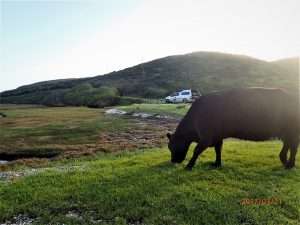Our collaborators from Oyvind Overli’s lab in Norway return this week to do stress tests and neurophysiology on our infected and uninfected experimental fish.
Bird collecting at Drakes Estero
Andrew and Ryan just spent about a week out of town, mostly seeking to collect estuarine birds at Drakes Estero for parasitology as part of our overall food web project. Drakes is a pretty gorgeous place, and is part of the National Park Service’s Point Reyes National Seashore. There is a lot of ranch land around there, and cows forage in some of our marshes!
DAN RETURNS FROM SENEGAL
Dan just spent three weeks in northern Senegal helping conduct field work and train lab personnel in parasite identification for a project ran by PIs from Stanford (Susanne Sokolow, Giulio De Leo) and UCSB (Armand Kuris). Human blood fluke infections (schistosomiasis) rose dramatically in this area following the construction of a dam on the Senegal River that blocked snail-eating prawns from migrating upriver. Snails are the intermediate host for blood flukes; removing their natural predators caused snails, and the blood flukes that infect them, to proliferate. The US PIs and the Senegalese non-profit Espoir Pour la Santé (Hope for Health) have partnered to assess whether blood fluke transmission can be reduced by reintroducing these natural predators.
SOLDIER CASTE ALSO IN HETEROPHYID TREMATODES
In another paper for Ana’s dissertation (congrats!), we find that four species of heterophyid trematodes also appear to have a caste of soldiers. This extends documentation of trematode soldiers to a new superfamily. We also examine a few early infections to test our ideas about how caste structure develops. See our publications page for Garcia-Vedrenne et al. (2017) Trematodes with a reproductive division of labor: heterophyids also have a soldier caste and early infections reveal how colonies become structured. International Journal of Parasitology. Ana also made a nice narrated slide show that summarizes the paper!
Origin of mysterious New Zealand mudsnail parasite
In a new lab publication, we work to pinpoint the origin of the mysterious fish blood fluke (aporocotylid) found in French populations of the invasive New Zealand mudsnail, in part by examining the phylogenetic relationships of a bunch of other fish blood flukes that we encountered in snails in NZ and Australia. It’s pretty clear that the European parasite came from New Zealand, just like its invasive host. See our publications page for Gerard et al. (2017) A native-range source for a persistent trematode parasite of the exotic New Zealand mudsnail (Potamopyrgus antipodarum) in France.


